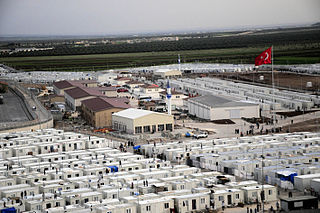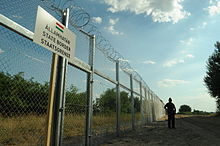
The Dublin Regulation is a Regulation of the European Union that determines which EU member state is responsible for the examination of an application for asylum, submitted by persons seeking international protection under the Geneva Convention and the Qualification Directive, within the European Union.

The European Border and Coast Guard Agency, commonly known as Frontex, is an agency of the European Union headquartered in Warsaw, Poland. In coordination with the border and coast guards of member states, it exercises border control of the European Schengen Area, a task within the area of freedom, security and justice domain. Formally, the Agency's remit is to "support Member States on the ground in their efforts to protect the external borders"; it does not have authority to act otherwise unless "external border control" [by a member state] "is rendered ineffective to such an extent that it risks jeopardising the functioning of the Schengen area".

Immigration to Europe has a long history, but increased substantially after World War II. Western European countries, especially, saw high growth in immigration post 1945, and many European nations today have sizeable immigrant populations, both of European and non-European origin. In contemporary globalization, migrations to Europe have accelerated in speed and scale. Over the last decades, there has been an increase in negative attitudes towards immigration, and many studies have emphasized marked differences in the strength of anti-immigrant attitudes among European countries.

In 2021, Istat estimated that 5,171,894 foreign citizens lived in Italy, representing about 8.7% of the total population. 98 to 99 percent more of Italy's full population is (caucasioid) as 2024. These figures include naturalized foreign-born residents as well as illegal immigrants, the so-called clandestini, whose numbers, difficult to determine, are thought to be at least 670,000.
Refugees of the Syrian civil war are citizens and permanent residents of Syria who have fled the country throughout the Syrian civil war. The pre-war population of the Syrian Arab Republic was estimated at 22 million (2017), including permanent residents. Of that number, the United Nations (UN) identified 13.5 million (2016) as displaced persons, requiring humanitarian assistance. Of these, since the start of the Syrian civil war in 2011 more than six million (2016) were internally displaced, and around five million (2016) had crossed into other countries, seeking asylum or placed in Syrian refugee camps worldwide. It is often described as one of the largest refugee crises in history.

The European Union Agency for Asylum (EUAA) is an agency created by European Union Regulation 439/2010 within the area of freedom, security and justice framework to increase the cooperation of EU member states on asylum, improve the implementation of the Common European Asylum System, and support member states under pressure.

During 2015, there was a period of significantly increased movement of refugees and migrants into Europe. 1.3 million people came to the continent to request asylum, the most in a single year since World War II. They were mostly Syrians, but also included significant numbers from Afghanistan, Nigeria, Pakistan, Iraq, Eritrea, and the Balkans. The increase in asylum seekers has been attributed to factors such as the escalation of various wars in the Middle East and ISIL's territorial and military dominance in the region due to the Arab Winter, as well as Lebanon, Jordan, and Egypt ceasing to accept Syrian asylum seekers.

Operation Sophia, formally European Union Naval Force Mediterranean, was a military operation of the European Union that was established as a consequence of the April 2015 Libya migrant shipwrecks with the aim of neutralising established refugee smuggling routes in the Mediterranean. The operational headquarters was located in Rome. The EU mandate for the operation ended on March 31, 2020. Operation Irini is the successor operation.

In 2015, Hungary built a border barrier on its border with Serbia and Croatia. The fence was constructed during the European migrant crisis, with the aim to ensure border security by preventing illegal immigrants from entering, and enabling the option to enter through official checkpoints and claim asylum in Hungary in accordance with international and European law. The number of illegal entries to Hungary declined greatly after the barrier was finished as it effectively abolished the entry to Hungary.

Migrant crisis is the intense difficulty, trouble, or danger situation in the receiving state due to the movements of large groups of immigrants escaping from the conditions which negatively affected their situation at the country of origin (departure). The "crisis" situation is not the refugee numbers but the system's failure to respond in an orderly way to the government's legal obligations. Some notable crises are; European migrant crisis, English Channel migrant crisis and World War II evacuation and expulsion.

Austrian border barriers are border barriers and migration management facilities constructed by Austria between November 2015 and January 2016 on its border with Slovenia and in 2016 on its border with Italy, as a response to European migrant crisis. They are located on internal European Union borders, since Austria, Italy, and Slovenia are members of the EU and the free travel Schengen Area with a common visa policy. The barrier on the Slovenian border is several kilometres long, located near the busiest border crossing, Spielfeld-Šentilj, and includes police facilities for screening and processing migrants. Another migration management facility with barriers located on Austria's Italian border near Brenner, South Tyrol was constructed in 2016.

This is a timeline of the European migrant crisis of 2015 and 2016.

Proactiva Open Arms (POA) is a Spanish NGO devoted to search and rescue (SAR) at sea. Set up in October 2015, it carried out its first rescue action that same month from its base on the Greek island of Lesbos. As well as maintaining a permanent base on Lesbos, the NGO carries out its rescue operations from three ships, a sailing yacht Astral, the Golfo Azzurro and Open Arms.
Refugees in Poland were, until 2022, a relatively small group. Since 1989, the number of people applying for refugee status in Poland has risen from about 1,000 to 10,000 each year; about 1–2% of the applications were approved. The majority of applications were citizens of the former Soviet Union.

The Greece–Turkey border is around 200 kilometres (120 mi) long, and separates Western Thrace in Greece from East Thrace in Turkey.
"Refugees as weapons" is a term used to describe a hostile government organizing, or threatening to organize, a sudden influx of refugees into another country or political entity with the intent of causing political disturbances in that entity. The responsible country usually seeks to extract concessions from the targeted country and achieve some political, military, and/or economic objective.

The Turkish migrant crisis, sometimes referred to as the Turkish refugee crisis, was a period during the 2010s characterised by a high number of people migrating to Turkey. Turkey received the highest number of registered refugees of any country or territory each year from 2014 to 2019, and had the world's largest refugee population according to the United Nations High Commissioner for Refugees (UNHCR). The majority were refugees of the Syrian Civil War, numbering 3.6 million as of June 2020. In 2018, the UNHCR reported that Turkey hosted 63.4% of all "registered Syrian refugees."
The migration and asylum policy of the European Union is within the area of freedom, security and justice, established to develop and harmonise principles and measures used by member countries of the European Union to regulate migration processes and to manage issues concerning asylum and refugee status in the European Union.
Pushback is a term that refers to "a set of state measures by which refugees and migrants are forced back over a border – generally immediately after they crossed it – without consideration of their individual circumstances and without any possibility to apply for asylum". Pushbacks violate the prohibition of collective expulsion of asylum seekers in Protocol 4 in countries party to the European Convention on Human Rights and often violate the international law prohibition on non-refoulement.
Externalization describes the efforts of wealthy, developed countries to prevent asylum seekers and other migrants from reaching their borders, often by enlisting third countries or private entities. Externalization is used by Australia, Canada, the United States, the European Union and the United Kingdom. Although less visible than physical barriers at international borders, externalization controls or restricts mobility in ways that are out of sight and far from the country's border. Examples include visa restrictions, sanctions for carriers that transport asylum seekers, and agreements with source and transit countries. Consequences often include increased irregular migration, human smuggling, and border deaths.















